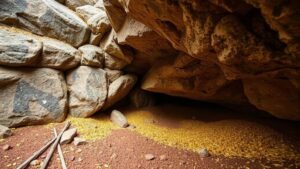The History of Spiritual Divination in Mining and Resource Hunting
The History of Spiritual Divination in Mining and Resource Hunting
The practice of divination–seeking knowledge of the future or the unknown through supernatural means–has a rich history that intertwines with various human activities, including mining and resource hunting. This article examines the historical contexts, methods, and cultural significance of divination in these fields, demonstrating how spiritual practices influenced resource acquisition and management throughout the ages.
Historical Context of Divination in Mining
Divination has been practiced since ancient times, with evidence of its use in various societies across the globe. In the context of mining, early civilizations often relied on divinatory practices to locate minerals and ores. ancient Egyptians, for instance, used augury and consulted oracles to determine the best locations for gold mining along the Nile.
Plus, the Chinese, as early as the Shang Dynasty (c. 1600-1046 BCE), employed methods such as the I Ching (Book of Changes) to guide decisions, including those related to mineral exploration. This historical reliance on divine insights underscores the interconnection between spirituality and resource procurement.
Methods of Divination in Resource Hunting
Various methods of divination have been employed throughout history, particularly in the context of mining and resource hunting. Key methods include:
- Dowsing: This ancient practice involves the use of a forked stick, rod, or pendulum to locate underground water, minerals, or metals. Dowsers claim intuitive senses guide them to the resource.
- Cartomancy: This method employs cards to gain insights about a particular location or situation. Miners might use it to divine the presence of a mineral vein.
- Scrying: Involving gazing into crystal balls or reflective surfaces, scrying has been utilized to gain visions or information about resource locations.
These methods reflect a deep-seated belief in the interconnectedness of the physical and spiritual worlds, aligning resource acquisition with divine guidance.
Case Studies in Spiritual Divination
Several historical case studies illustrate the effectiveness and significance of divination in mining and resource hunting:
- The Gold Rush in California: During the mid-19th century, many prospectors turned to local shamans and indigenous practices to seek advice on promising mining sites. While some achieved great success, others found little more than folly, showcasing the mixed outcomes associated with these spiritual beliefs.
- The Mesoamerican Civilizations: In ancient Central America, the Maya and Aztec cultures utilized divination to guide their resource management strategies. They consulted priests to interpret omens relating to rainfall patterns critical for successful agriculture and mining.
These examples highlight how varying degrees of success often accompanied divination practices, blending spirituality with pragmatic resource management.
Modern Interpretations and Applications
Today, while scientific methods have largely supplanted spiritual divination in most advanced mining operations, elements of divination persist in certain cultures and communities. For example, some indigenous groups continue to utilize traditional practices, believing they foster a respectful relationship with the land.
Also, there has been a revival of interest in holistic approaches to resource management, where intuition and community knowledge are considered valuable alongside technological advancements. This blending can create innovative strategies that honor both tradition and modernity.
Conclusion
The history of spiritual divination in mining and resource hunting illustrates a fascinating intersection of culture, spirituality, and economics. While the methods and beliefs have evolved, the core motivation remains: the quest for sustenance and prosperity linked to the natural world. Understanding these historical practices not only enriches our knowledge of resource acquisition but also highlights the enduring human connection to the earth and its treasures.
As we move forward, integrating traditional ecological knowledge with modern scientific practices may lead to more sustainable resource management strategies, honoring both the spiritual and material landscapes we navigate.


